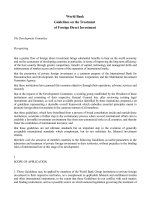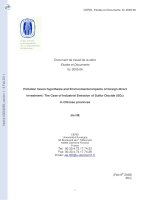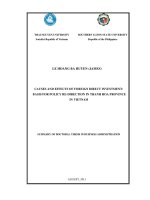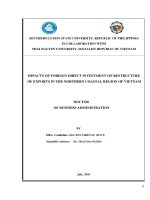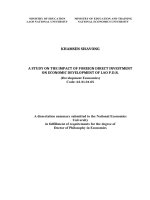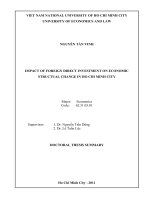Global regulation of foreign direct investment
Bạn đang xem bản rút gọn của tài liệu. Xem và tải ngay bản đầy đủ của tài liệu tại đây (2.78 MB, 225 trang )
GLOBAL REGULATION OF FOREIGN
DIRECT INVESTMENT
To Hirut, Hayat and Iman
Global Regulation of Foreign Direct
Investment
SHERIF H. SEID
LLB (AAU, DISTINCTION); LLM, PHD (ANU)
First published 2002 by Ashgate Publishing
Reissued 2018 by Routledge
2 Park Square, Milton Park, Abingdon, Oxon OX14 4RN
711 Third Avenue, New York, NY 10017, USA
Routledge is an imprint of the Taylor & Francis Group, an informa business
Copyright © Sherif H. Seid 2002
The author has asserted his moral right under the Copyright, Designs and Patents Act, 1988, to be identified as the author of this work.
All rights reserved. No part of this book may be reprinted or reproduced or utilised in any form or by any electronic, mechanical, or other
means, now known or hereafter invented, including photocopying and recording, or in any information storage or retrieval system, without
permission in writing from the publishers.
Notice:
Product or corporate names may be trademarks or registered trademarks, and are used only for identification and explanation without
intent to infringe.
Publisher’s Note
The publisher has gone to great lengths to ensure the quality of this reprint but points out that some imperfections in the original copies
may be apparent.
Disclaimer
The publisher has made every effort to trace copyright holders and welcomes correspondence from those they have been unable to
contact.
A Library of Congress record exists under LC control number: 2002100900
ISBN 13: 978-1-138-73867-6 (hbk)
ISBN 13: 978-1-315-18463-0 (ebk)
Contents
List of Figures
List of Tables
Preface
Acknowledgments
List of Laws, Agreements and Conventions
Acronyms
PART I: THE THEORY OF FOREIGN DIRECT INVESTMENT: THE LAW OF FDI
1 Introduction
2 FDI Theories and the Role of the State
3 The Current Regulatory Framework for FDI
4 Methodology
PART II: STRATEGIES FOR A GLOBAL INVESTMENT AGREEMENT: THE KEY
PLAYERS
5 The OECD Countries and the OECD Agenda
6 Developing Countries
7 Consumer, Labour, Environmental and Business Groups
8 International Organisations
PART III: EVALUATION: TOWARDS REGULATED OPENNESS
9 Evaluation of the Strategies
10 Regulated Openness
11 Conclusion
Bibliography
Index
List of Figures
Figure 2:1 Nationalisation by Year
Figure 5:1 Japanese Investment in the US, 1980-90 (in billions of US dollars)
List of Tables
Table 2:1 Countries that Conducted Mass Nationalisation
Table 3:1 Changes to National Regulatory Regimes on FDI, 1991-98
Table 4:1 Interviews Conducted in 1996 and 1997
Table 5:1 Rows of Direct Investment out of and into the US, 1970-90 (in billions of US dollars)
Table 5:2 High Technology Acquisitions in the US by country (October 1988-April 1992).
Table 5:3 Japan’s High Technology Acquisition in the US (October 1988-April 1992, by industry)
Table 6:1 Percentage Share of FDI in Gross Fixed Capital Formation (1971-93)
Table 8:1 Positions taken by Some Countries/Groups at the WTO Seattle Ministerial Conference
Table 10:1 Issues to be Addressed in a Global Investment Agreement and the Representative
Positions of the Key Players
Table 10:2 Comparison of the MAI and Regulated Openness
Preface
Foreign direct investment (FDI) can contribute positively to the economic development of the host
country. Foreign investors usually bring capital into the host country, thereby influencing the quality
and quantity of capital formation in the host country. The inflow of capital and reinvestment of profits
increases the total savings of the country and the tax revenue of the Government. FDI can also
increase the level of economic activity and social wellbeing in the host country. It can replace
inferior production functions in developing countries with superior ones through the transfer of
technology, managerial and marketing skills, market information, organisational experience,
innovation in products and production techniques, and the training of workers. Moreover, FDI can
increase competition in an industry with a likely improvement in productivity. FDI can also widen the
market for host country producers by linking the host country industry more closely to world markets,
leading to even greater competition and opportunities to technology.
However, if prudent regulatory mechanisms are not in place, FDI may not always be beneficial to
the host country. It can, for example, cause considerable environmental damage. In some cases such
environmental destruction has led to major social unrest, including calls for secession and civil war
(e.g. Bougainville). Some foreign investors may even seek investment in a developing country to
escape the burden and costs of stringent environmental regulations in their home countries.
Multinational corporations (MNCs) may also involve themselves in transfer pricing, thereby
negatively affecting the host government’s tax revenue. Moreover, there have been instances where
foreign MNCs were involved in internal political affairs of host countries, causing civil unrest and
political instability in the host country (e.g. Chile).
After the failure of the Multilateral Agreement on Investment (MAI), the world does not have a
global investment agreement that would regulate FDI. A global investment agreement dealing with
FDI would clearly fill a large gap in the network of regulatory measures governing the world
economy. Other attempts had been made prior to the MAI to address this problem, but all have failed
so far. The main reason for such failures has always been the lack of compromise in the positions
held by the major stakeholders. This book analyses the pros and cons of these opposing positions and
uses them as a basis for forging a hybrid model called “Regulated Openness”. This hybridity is thus
grounded in compromise and pragmatism. But it is a principled pragmatism in two ways. First, the
book analyses the weaknesses and strengths of the positions of all the key players in the FDI debate in
search of a marriage of these positions where the strengths of one might cover the weaknesses of the
other. Second, the book defends a method motivated by the question: What is the best kind of FDI
agreement from the starting point of the reality of the key players’ present positions? This is seen as
more productive method than crafting a model from purely analytic foundations that would not apply
to any existing world because it would abstract from real positions of real players. In the method
applied here, the role of analytic economics, for example, is still important, yet mostly limited to
uncovering the weaknesses and strengths of extant economic postures in global politics.
The key players whose positions are described and diagnosed in this book are the OECD and its
members, developing countries, public interest groups and representatives of the business community,
and international organisations. The method used to collect these data were interviews, cyber
observation, attendance of conferences, observation of negotiations and literature review.
Regulated openness is a compromise where the concerns of each major stakeholder would be
addressed adequately. It has procedural and substantive dimensions. Procedurally, it is a process
where all major stakeholders would have an input and role in the preparation and implementation of
FDI laws. A binding international framework agreement on principles is a more pragmatic solution
than comprehensive rules. Once the framework agreement of core principles has been formed, each
country would have its own detailed rules consistent with the internationally agreed principles and
the priorities of individual countries. Substantively, regulated openness means an investment regime
where both regulation and openness co-exist in a balanced and pragmatic manner. This balance and
co-existence could be achieved within a framework of internationally agreed core principles rather
than detailed comprehensive rules. The core principles will be those principles which major
stakeholders would regard as paramount, namely sustainable development, enhanced openness of
markets, investment security, core labour standards, consumer protection and business ethics, good
governance and effective dispute settlement. Moreover, host countries would commit themselves to
continuously improve their openness policies as their domestic capability improves and as the
guarantees they can secure under the other core principles strengthens.
Regulated openness aims at bringing development with justice. Development with justice requires
both procedural justice and credible commitment to continuous improvement of the openness of
investment policy, investment security, sustainable development, core labour standards, consumer
protection, business ethics and good governance. A commitment to continuously improve these
concerns is a path for development with justice. As such, it is a path to politically sustainable
liberalisation, as distinct from the politically disastrous trajectory of the MAI. Through seeing why
the MAI failed, as an exclusionary agreement that cloaked discrimination against domestic investors
as nondiscrimination against FDI, we might grasp how regulated openness could succeed. We also
grasp how the seeds of the unsettling of the Millennium Round of the World Trade Organisation
(WTO) were sown by the NGO and developing country campaign against the MAI. What they ushered
in was perhaps a new era when the powerless have some capacity to scuttle the plans of the powerful
for the commanding heights of the world economy.
Sherif H. Seid
March 2002
Acknowledgments
I am indebted to a number of people who have contributed to the success of this book either directly
or indirectly. First and foremost, I would like to Professor John Braithwaite for his advice,
inspiration, comments, extraordinary support and commitment for the project. I would also like to
thank Dr. Peter Drahos his very useful comments and extraordinary support. John and Peter have been
cardinal for the successful completion of, first, my PhD course, and then this book. Some draft
Chapters of the book have benefited from the useful comments of Professor Don Greig, for which I am
grateful. I am also thankful to the various people who volunteered to be interviewed during my field
research.
The support of the Law Program, Research School of Social Sciences was very important for the
completion of my study and the book. I am particularly grateful to Professor Peter Cane, Head of the
Program, and Ms Chris Treadwell for their administrative support. I would also like to thank Nathan
Harris and Jennifer Balint for their companionship.
Finally, I am greatly indebted to my wife, Hirut Yigezu for giving me much needed support and
encouragement throughout my course of study and the writing of the book, even in the most difficult
times. Because of her, I shall always remember with pleasure the time I spent writing this book. My
gratitude should also go to my beloved children, Hayat and Iman for giving me much of their leisure
time as their contribution to my success.
List of Laws, Agreements and Conventions
Agreement between the Belgio-Luxemburg Economic Union and the Government of the Republic of
Korea, Signed on December 20, 1974.
Agreement on Economic Cooperation between the Government of the Kingdom of the Netherlands
and the Republic of Uganda.
APEC Non-Binding Investment Principles.
Broadcasting and Services Act 1992 (of Australia).
Compensation (Prohibition of Foreign Proceedings) Act 1995, of Papua New Guinea.
Convention on the Settlement of Investment Disputes between States and Nationals of Other States.
Defence Authorisation Act of 1993 (United States).
Foreign Investment Act 1990 (of Namibia).
Foreign Investment and Technology Act, 2038 (of Nepal).
General Agreement on Trade in Services (GATS).
Investment Code, 1991 (of Uganda).
Investment Incentives Council of Ministers Regulation No. 7/1996 (of Ethiopia).
Investment Law No. 230 for 1989 (of Egypt).
Law on Foreign Investment, 1987 (of Vietnam).
The American Pre-eminence Act of 1991.
The Commercial Fishing Industry Vessel Anti-reflagging Act of 1987 (United States).
The Convention Establishing the Multilateral Investment Guarantee Agency.
The Cuban Liberty and Democratic Solidarity Act of 1996 (United States).
The Defence Application Act of 1993 (United States).
The Federal Power Act (United States).
The Geothermal Steam Act (United States).
The National Cooperation Production Act of 1993 (United States).
The National Investment (Promotion and Protection) Act, 1990 (of Tanzania).
The North American Free Trade Agreement (NAFTA).
The Nuclear Energy Act (United States).
WTO Agreement on Trade Related Investment Measures (TRIMS).
Acronyms
ABC
Australian Broadcasting Corporation
ACA
Australian Consumers Association
ACCC
Australian Consumers and Competition Commission
ACP
Asia-Carribean-Pacific
APEC
Asia-Pacific Economic Cooperation
ASEAN
Association of East Asian Nations
BIAC
Business and Industry Advisory Council of the OECD
BIT
Bilateral Investment Treaty
CEO
Corporate Europe Observatory
CI
Consumers International
CIS
Commonwealth of Independent States
CNT
Conditional National Treatment
CUTS
Consumer and Unity Trust Organisation
EC
European Commission
ECOSOC
UN Economic and Social Council
EPZ
Export Processing Zone
FDI
Foreign Direct Investment
FIAS
Foreign Investment Advisory Service
G7
Group of Seven
GATS
General Agreement on Trade in Services
GDP
Gross Domestic Product
GNP
Gross National Product
GPS
Generalised System of Preferences
IBRD
International Bank for Reconstruction and Development
ICC
International Chamber of Commerce
ICFTU
International Confederation of Free Trade Unions
ICSID
The International Centre for the Settlement of Investment Disputes
ICSIR
Indian Council of Scientific and Industrial Research
IDA
International Development Association
ILM
International Legal Material
ILO
International Labour Organisation
IMCB
International Medical Commission on Bhopal
IMF
International Monetary Fund
IOCU
International Organisation for Consumer Union
ITO
International Trade Organisation
LIBERTAD
Cuban Liberty and Democratic Solidarity Act of 1996
M&A
Merger and Acquisition
MAI
Multilateral Agreement on Investment
MFN
Most-Favoured-Nation Treatment
MIC
Methyl Iso-Cyanate
MIGA
Multilateral Investment Guarantee Agency
MNCs
Multinational Corporations
MNE
Multinational Enterprise
NAFTA
North American Free Trade Agreement
NEP
New Economic Policy
NGO
Non-Governmental Organisation
NT
National Treatment
OECD
Organisation for Economic Cooperation and Development
OPEC
Organisation of Petroleum Exporting Countries
OTML
Ok Tedi Mining Limited
PCIJ
Permanent Court of International Justice
PNG
Papua New Guinea
R&D
Research and Development
RBP
Restrictive Business Practice
TNC
Trans-National Corporation
TRIMs
Trade-Related Investment Measures
TRIPS
Trade-Related Aspects of Intellectual Property Rights
TUAC
Trade Union Advisory Council of the OECD
UCC
Union Carbide Corporation
UK
United Kingdom
UN
United Nations
UNCITRAL
International Commission of International Trade Law
UNCTAD
United Nations Conference on Trade and Development
UNCTC
United Nations Centre for Transnational Corporations
UNEP
United Nations Environment Programme
UNICE
Union of Industrial and Employers’ Confederations of Europe
UNIDO
United Nations Industrial Development Organisation
US
United States of America
USTR
United States Trade Representative
WGTI
Working Group on Trade and Investment
WTO
World Trade Organisation
WWF
World Wide Fund for Nature
Part I
The Theory of Foreign Direct Investment: The
Law of FDI
Chapter 1
Introduction
Foreign Direct Investment (FDI) plays a significant role in the development process of most
economies, and today it has become an integral part of higher living standards and economic
prosperity. FDI is also a key determinant of trade since a large percentage of trade occurs between
affiliated companies. According to the United Nations Conference on Trade and Development
(UNCTAD), trade within MNCs and arms length trade associated with MNCs are estimated to
account, together, for two-thirds of world trade, and intra-firm trade alone, for one-third (UNCTAD,
1999). A large number of countries around the world spend enormous resources and time in designing
and implementing policies that would attract FDI to their respective territories.
Foreign investment enables investors to look beyond the constraints of their domestic investment
environment and gain access to resources and bigger markets, and maximise investment returns.
However, such transnational activities pose unique challenges to national governments (in addition to
the opportunities they bring with them). Multinationally located and transnationally integrated
company operations would give MNCs more independence from a national government’s policy
directions (particularly when the host country is a small, developing nation). During the 1960s and
1970s, several clashes arose between MNCs and host governments, and between host and home
governments of these companies, over a range of regulatory issues affecting MNC operations.
This book analyses the regulation of FDI both nationally and internationally and the problems
associated with it. It also proposes a pragmatic global regulatory framework that would solve the
current stalemate on a multilateral investment agreement. The book is divided into three major parts.
Part One
The first part consists of three further chapters. Chapter Two discusses the theories that have had
major influence in the past decades on national and international investment regulation. These
theories are neo-classical economic theory, dependency theory and the theories of state intervention
in economic activity. As the discussion in Part II will show, these theories, particularly neo-classical
economics and theories of state intervention in economic development seem to have a major
influence in the positions and strategies of the key international players. Therefore, each of these
theories will be examined briefly in Chapter Two, and their impact on national and international rule
making on FDI will be assessed. The benefits FDI brings to the host economy and its possible
negativities will also be examined in light of these theories. The role of the State in addressing
market failures and the pros and cons of state intervention will be analysed.
Chapter Three analyses the scope of coverage and weaknesses/strengths of the current rules on
FDI. The current rules on FDI can be broadly categorised as national, bilateral and multilateral. The
multilateral rules can be further classified as regional/sectoral and global. National laws set the rules
for the establishment, operation and liquidation of business enterprises. Although broader in scope,
national laws have geographical limits in their applicability. Whatever international arrangements
we have at the moment, their scope is limited either geographically or in scope. Moreover, the
diversity of national and international legal regimes governing FDI would introduce excessive
distortions as between countries and sectors (Fatouros, 1996: 59). Chapter Two examines all of
these issues in detail and puts a case for global investment rules/principles.
Chapter Four discusses the methodology used in this research. Multiple methods have been
developed, and Chapter Four explains them all.
Part Two
The second part of the book consists of four chapters that examine the strategies of the key
international players for global FDI regulation. The influence of the theories discussed in Chapter
One will become more apparent throughout Part Ii. Chapter Five discusses the strategies of the
Organisation for Economic Cooperation and Development (OECD) and OECD countries. Key
players among the OECD countries are the US, the EC and Japan. The Chapter also examines the
Multilateral Agreement on Investment (MAI) in detail, from its inception to its eventual burial.1 The
MAI was negotiated exclusively by OECD countries, and largely in secrecy. The intention was to
invite other countries to sign once an Agreement has been reached among OECD states. Although
OECD countries as a group hoped that the MAI would remove barriers to market access and enhance
the liberalisation of investment rules, each of the three main players within the group had their own
distinct priorities when they first decided to start negotiating the Agreement. This Chapter, therefore,
examines the policies and strategies of the three major players. The contents of the MAI will be
analysed in detail. The reasons for and the forces behind the MAI’s failure to materialise will also
be discussed.
Chapter Six discusses the strategies of developing countries for a global investment regime. The
key players in developing countries do not have a common strategy for a global investment regime at
this point in time. Their views are divided on whether to have such a regime in the first place,
secondly on the appropriate forum for the negotiation and implementation of such a regime, and
thirdly on the nature and emphasis of the regime, should a decision be made to have one. Their views
were also divided on the extension of the MAI to nonOECD countries. Most developing countries
generally accept that FDI could make big contributions to their development efforts. There is
however concern that, when the major interests of MNCs and host States are in conflict, MNCs may
use their muscle as well as the influence of their home countries to interfere in the domestic affairs of
weaker host countries. Moreover, a global framework that would allow foreign investors to take the
host country to international tribunals without the latter’s consent is seen as a measure that would
severely erode the sovereignty of host nations. It is therefore argued that FDI could only be beneficial
to host economies if host countries can regulate and direct it according to their development
objectives. The model of agreement proposed by the proponents of the MAI was opposed by many
developing countries partly because it required host countries to give up their right to adopt a
selective approach to foreign investment to promote their chosen development strategy. Moreover,
any proposal that would give rights and protection to foreign investors, but not corresponding
obligations would not be acceptable to these countries. The question of venue has also been as
controversial as the substantive content of the future agreement itself. While there are some
developing countries that want to negotiate the global agreement within the framework of the World
Trade Organisation (WTO), others reject this and propose that the UNCTAD would be the
appropriate forum. Chapter Six examines all of these issues in detail.
Chapter Seven discusses the strategies and positions of social movements (such as consumer,
environmental and labour movements) and key international business associations (such as the
International Chamber of Commerce and the Business and Industry Advisory Council of the OECD
for global investment rules. International non-governmental organisations (NGOs) play key roles in
shaping international rules and institutions (Braithwaite and Drahos, 2000). If the strategies they
followed and the positions they took during the MAI debate are of any indication, consumer
advocates, environmentalists and labour unions have commonality on most of the issues regarding
FDI regulation, while business representatives stand on the opposite side. The first three groups
formed a broad coalition in their stand against the MAI and unleashed a rigorous campaign to kill it.
Business representatives largely gave strong backing to the MAI, to the extent of being accused of
initiating and driving the negotiation process.
Despite the potentially positive contributions of FDI, consumer advocates, environmentalists and
labour unions fear that because of their economic power and, in some instances, lack of
accountability to host countries, MNCs have the potential to limit competition and force consumers to
face less choice and higher prices. They also fear that MNCs could trigger the lowering of
environmental, labour and other standards as host countries compete to attract foreign investors to
their territories; or they may behave unethically by, for example, artificially avoiding taxes or
indulging in corrupt practices. The business community largely supports an international investment
regime because they believe that such a regime could be a tool for greater market access and better
predictability of rules. Chapter Seven examines all of these issues in detail.
Chapter Eight discusses the roles of the major inter-governmental organisations in the process of
making rules for FDI, since international organisations play significant roles in shaping the global
regulatory regime. The organisations covered in the discussion are the United Nations, the WTO, the
World Bank and the Asia-Pacific Economic Cooperation (APEC). The United Nations has played
significant role in the debate about global investment rules. The UN was involved in facilitating the
drafting of a Code of Conduct for MNCs until the early 1990s. Since then, it has also been active in
the debate through UNCTAD. The WTO too is involved in the debate about global investment rules
and, in fact, regulates FDI in a limited way. For examples, the Agreement on Trade-Related
Investment Measures (TRIMS) deals with investment measures that have prohibitive effects upon
trade in goods. One of the purposes of the World Bank as enshrined in its Article of Agreement is “to
promote private foreign investment”. Three other institutions created under the Bank’s auspices
complement its operations in support of the promotion of foreign investment. These institutions are
the International Finance Corporation (IFC), the International Centre for the Settlement of Investment
Disputes (ICSID), the Multilateral Investment Guarantee Agency (MIGA). In addition, in 1992, the
World Bank adopted a set of non-binding Guidelines for the treatment of FDI. The regional
organisation APEC, too, has adopted non-binding guidelines for the treatment of foreign investment
in the Asia-Pacific region. Although some success has been seen at regional levels, none of the
global organisations have so far succeeded in developing a comprehensive global investment regime
acceptable to all countries. Several attempts to develop such a regime in the past have failed. The
issues surrounding all of these activities will be discussed in detail in Chapter Eight.
Part Three
The third part consists of three chapters that evaluate the strategies of the key players and proposes a
pragmatic regulatory framework. Developed countries, multilateral financial institutions like the IMF
and World Bank, business groups and some developing countries advance the idea of having a more
liberal regime at both global and national levels. Other developing countries and various NGOs,
such as consumer organisations, environmental activists and the labour movement, on the other hand,
see danger in an extensive liberalisation of investment rules and argue that what is needed is
regulation. Chapter Nine evaluates these positions. It attempts to highlight the cons and pros of both
excessive liberalisation and excessive regulation. Moreover, the implications of the Multilateral
Agreement on Investment (MAI) will be discussed.
Chapter Ten explores an alternative approach in the regulation of FDI, called “regulated
openness”, which is a pragmatic and hedged model that seeks to preserve the strengths and cover the
shortcomings uncovered in the regulatory models of the different players. It starts by asserting that the
current approach in attempting to formulate an international regime for FDI has serious flaws, both in
the manner negotiations are conducted and the substantive content of the rules. It then proposes a
middle-ground position called “regulated openness”, where the interests and concerns of all major
international players could be accommodated in a balanced and pragmatic way, both regarding the
manner in which the negotiations would be conducted and the substantive content of the rules. The
Chapter consists of two major parts. The first discusses the structure of the principles/rules under
“regulated openness”, both at the international and national levels, and the content of the
principles/rules at the international level. The second part covers the process of negotiating the
international agreement, venue, and implementation of the rules.
Chapter Eleven summarises the entire book and draws conclusions about the contribution the ideas
in this book could make in the debate on global investment rules.
Notes
1 The MAI is a draft investment agreement that had been negotiated by the OECD countries from April 1995 to May 1998 under the
sponsorship of the OECD Secretariat. The negotiation was planned to be completed in April 1997 initially, but later the deadline was
extended to April 1998. Because of the enormous controversy it generated both within the OECD grouping and around the world,
the negotiation was suspended indefinitely in May 1998 and the Agreement has not been signed as of this date.
Chapter 2
FDI Theories and the Role of the State
Theories, economic or otherwise, play an important role in shaping legal attitudes. With regard to
FDI, the theories discussed in this Chapter seem to have played a dominant role in shaping the legal
regimes both nationally and internationally. These are neoclassical economic theory, dependency
theory, and theories of state intervention in economic development
Neo-classical economic theory is the main driving force behind the global push for the
liberalisation of trading and investment regimes. As such, it has played (and is playing) a significant
role in the debate about global investment rules. Dependency theory, on the other hand, seems to be
losing its influence in global rule making, but it has been a significant force in the rule making process
so far, as the anti-book of neo-classical economics. However, the various theories on the benefits of
State-intervention in the marketplace seem to be replacing dependency theory in the contemporary
debate on global FDI rules. This Chapter will traverse a brief overview of all of these theories.
Neo-classical Economic Theory on FDI
The definition of neoclassical economics is not perfectly clear. It has meant different things to
different writers. These different meanings include: the subjective marginal utility theory of the
1870s and beyond; the economics of Alfred Marshall (Marshall, 1879); the work of twentieth century
writers in the tradition established by Marshall and some others; some combination of the foregoing;
and the Samuelsonian synbook of price and resource allocation theory with Keynesian
macroeconomics (Kennings and Samuels, 1999: 3).
Neoclassicism has also had a variety of technical meanings as to its central problem: “the
mechanics of utility, price determination or operation of price mechanism, the working of free
enterprise system, the operation of pure markets, the mechanics of the pure theory or logic of choice,
constrained maximisation decision making, the allocation of resources, and so on” (Kennings and
Samuels, 1999: 3). This study does not attempt to discuss the neoclassical school of economic
thought in detail. Rather, the attempt will only be to discuss the position the school takes FDI.
Neoclassical economic theory propounds that FDI contributes positively to the economic
development of the host country (Bergten et al, 1978: 355). There are several factors that are relied
on to support this view. One such factor is that foreign investors usually bring capital into the host
country, thereby influencing the quality and quantity of capital formation in the host country. The
inflow of capital and reinvestment of profits increases the total savings of the country. Government
revenue increases via tax and other payments (Bureau of Industry Economics, 1995: 7). The fact that
foreign capital is brought into the host country also ensures that domestic capital available for use
could be redirected to other uses (Sornarajah, 1994: 38). Moreover, the infusion of foreign capital
into the host economy reduces the balance of payments constraints of the host country. In general, FDI
increases the level of economic activity, and hence the level of social wellbeing.
The other principal argument in favour of the neoclassical theory is that FDI, particularly in
developing countries, plays the role of a “tutor”. It replaces the inferior production function in
developing countries by a superior one from advanced industrialised countries through the transfer of
technology, managerial and marketing skills, market information, organisational experience,
innovation in products and production techniques, and the training of workers (Kojima, 1978: 152).
Particularly multinational corporations (MNCs) are regarded as useful agents for the international
transfer of technology and knowledge.
High technology MNCs generally prefer to service foreign markets through wholly owned
subsidiaries to ensure that their patent and trademark rights are honoured and that the quality control
associated with their well-established brand names is safeguarded (UNCTAD, 1996). Also, MNCs
can have greater flexibility in minimising their global tax liabilities if they own their foreign
affiliates. One of the most effective ways through which MNCs transfer knowhow and technology to
other countries is therefore through their foreign affiliates (UNCTAD, 1993: 176). Moreover,
although investors generally seek to protect their technology and knowhow in order to exploit their
firm-specific advantage, over time it leaks to other firms through the movement of staff, formal and
informal communication networks among professionals, input suppliers, and customers and joint
venture partners (Bureau of Industry Economics, 1995: 9). The host country benefits from these
transfers without directly compensating the investor.
While MNCs, through their foreign affiliates, can serve as the primary channel for the transfer of
technology from industrially developed to developing countries, the welfare gains to the latter of
adopting technologies depends largely upon the extent to which these innovations are diffused locally
and prices are reduced. According to Antonelli, the cost of adoption is affected by the following five
factors (Antonelli, 1991):
the availability of information about the technology from other users;
the availability of trained and skilled manpower;
the availability of technical assistance and maintenance;
the availability of complementary equipment and software;
the availability of complementary innovations, both technological and organisational.
In developing countries all of these factors are likely to be relatively scarce and, hence, the cost of
adopting a new technology could be high.
The proponents of neoclassical theory further argue that FDI increases competition in an industry
with a likely improvement in productivity (Kojima, 1978: 153; Bureau of Industry Economics, 1995:
7). Increased competition can lead to reallocation of resources to more productive activity across the
economy, reduction of overmanning, efficient utilisation of capital, and removal of poor management
practices. FDI can also widen the market for host country producers by linking the host country
industry more closely to world markets, leading to even greater competition and opportunities to
technology transfer (Bureau of Industry Economics, 1995: 7).
Finally, it is said that FDI generates employment, influences favourably the distribution of income
and power within the host country, and generates foreign exchange thereby easing the balance of
payments constraints of the host country (Reuber et al, 1973: 22; Sornarajah, 1994: 38; Bergten
1978: 355). Infrastructure facilities would be built or upgraded by or for the foreign investor and
these facilities would be to the general benefit of the economy (Sornarajah, 1994: 38-39). According
to the important and controversial World Bank East Asian Miracle report, eight South East Asian


